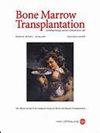Role of bridging RT in relapsed/refractory diffuse large B-cell lymphoma undergoing CAR-T therapy: a multicenter study
IF 4.5
2区 医学
Q1 HEMATOLOGY
引用次数: 0
Abstract
The optimization of bridging regimen before chimeric antigen receptor (CAR)-T cell therapy in diffuse large B-cell lymphoma (DLBCL) may impact CAR-T efficacy and outcome. This retrospective study evaluates CAR-T outcome after bridging with radiotherapy (RT) and other bridging strategies. Among 148 patients with relapsed/refractory DLBCL who underwent leukapheresis for CAR-T manufacturing, 31 received RT-bridging, 84 chemotherapy (CT), 33 no-bridging or steroid-only. CAR-T cell were infused in 96.8% of RT-group, 89.2% of CT-group and 78.8% of no-bridge-group (p = 0.079). Response to bridging was generally poor, but patients receiving RT had a significant reduction in LDH levels between pre- and post-bridging (p = 0.05). The one-year PFS was 51.2% in the RT-group, 28.2% in the CT-group, and 47.6% in the no-bridge-group (p = 0.044, CT-bridging vs RT-bridging); 1-year OS was 86.7% in the RT-group, 52.7% in the CT-group and 69% in the no-bridge-group (p = 0.025, CT-bridging vs RT-bridging). We observed a higher incidence of ICANS in patients who received CT than in others (20.0% CT-group, 3.3% RT-group, 7.7% no-bridge group; p = 0.05). In conclusion, RT-bridging is associated with lower drop-out rate and CAR-T toxicity, and it might be preferred to other bridging strategies for patients with localized disease or for those with one prevalent symptomatic site.

桥接 RT 在接受 CAR-T 疗法的复发/难治弥漫大 B 细胞淋巴瘤中的作用:一项多中心研究。
嵌合抗原受体(CAR)-T 细胞治疗弥漫性大 B 细胞淋巴瘤(DLBCL)前桥接方案的优化可能会影响 CAR-T 的疗效和结局。这项回顾性研究评估了与放疗(RT)和其他桥接策略桥接后的CAR-T疗效。在148例复发/难治性DLBCL患者中,有31例接受了RT桥接,84例接受了化疗(CT),33例未接受桥接或仅接受类固醇治疗。96.8%的RT组、89.2%的CT组和78.8%的无桥接组都输注了CAR-T细胞(P = 0.079)。桥接反应普遍较差,但接受RT治疗的患者在桥接前和桥接后的LDH水平显著下降(p = 0.05)。RT组的1年PFS为51.2%,CT组为28.2%,无桥组为47.6%(P = 0.044,CT桥接与RT桥接对比);RT组的1年OS为86.7%,CT组为52.7%,无桥组为69%(P = 0.025,CT桥接与RT桥接对比)。我们观察到,接受 CT 治疗的患者 ICANS 发生率高于其他患者(CT 组 20.0%,RT 组 3.3%,无桥组 7.7%;P = 0.05)。总之,RT桥接与较低的退出率和CAR-T毒性相关,对于局部疾病患者或只有一个症状部位的患者,RT桥接可能比其他桥接策略更适合。
本文章由计算机程序翻译,如有差异,请以英文原文为准。
求助全文
约1分钟内获得全文
求助全文
来源期刊

Bone Marrow Transplantation
医学-免疫学
CiteScore
8.40
自引率
8.30%
发文量
337
审稿时长
6 months
期刊介绍:
Bone Marrow Transplantation publishes high quality, peer reviewed original research that addresses all aspects of basic biology and clinical use of haemopoietic stem cell transplantation.
The broad scope of the journal thus encompasses topics such as stem cell biology, e.g., kinetics and cytokine control, transplantation immunology e.g., HLA and matching techniques, translational research, and clinical results of specific transplant protocols. Bone Marrow Transplantation publishes 24 issues a year.
 求助内容:
求助内容: 应助结果提醒方式:
应助结果提醒方式:


